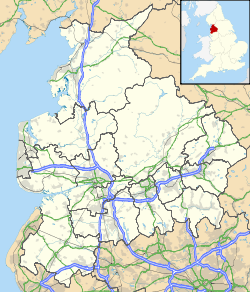- St Andrew's Church, Leyland
-
St Andrew's, Leyland 
Location in Lancashire Coordinates: 53°41′19″N 2°41′47″W / 53.6887°N 2.6963°W OS grid reference SD 54111 21591 Location Leyland, Lancashire Country England Denomination Anglican Architecture Status Parish church Functional status Active Heritage designation Grade II* Designated 26 July 1951 Administration Deanery Leyland Archdeaconry Blackburn Diocese Blackburn Province York St Andrew's Church is an Anglican church in Leyland, Lancashire, England. It is an active parish church in the Diocese of Blackburn and the archdeaconry of Blackburn. The church has been designated a Grade II* listed building by English Heritage.
Contents
History
Historically, the ecclesiastical parish of Leyland was large and encompassed the townships of Leyland, Euxton, Cuerden, Clayton-le-Woods, Whittle-le-Woods, Hoghton, Withnell, Wheelton, and Heapey.[1] There was likely a Norman church on the site of the present structure.[2] In the 12th century, Warine Bussel, baron of Penwortham, gave the church to Evesham Abbey in Worcestershire.[1] From the 14th century, vicars were appointed to Leyland church by the abbey. Following the Dissolution of the Monasteries in the 16th century, the advowson for the church (the right to nominate a priest) was transferred to John Fleetwood of Penwortham.[1]
The chancel was built in the 14th century and the tower probably dates from the late 15th or early 16th century.[1][2] The older nave was replaced 1816–17, to a design by a Mr Longworth.[1] The church was restored in 1874 by Lancaster-based architecture firm Paley and Austin.[3] The nave roof was replaced 1951–53, and the chancel roof in 1956.[2]
Architecture
Exterior
St Andrew's in constructed of stone; its roofs are stone slate and copper.[4] The plan consists of a nave with a square tower to the west and a chancel to the east. North of the chancel is a vestry. The tower is crenellated with four-stage buttresses at its corners and has a moulded plinth.[1] Three sides of the tower have clocks and there are three-light, arched belfry louvres on all sides.[4]
The Gothic-style nave has a crenellated parapet and a copper roof.[4] It has five three-light windows in its north and south walls.[1] The windows are arched, with tracery.[4] The chancel is low and narrow in comparison to the nave. Its three-light, arched windows also have tracery. The east window has three lights under a pointed arch, with chamfered mullions.[1]
Interior and fittings
The inside of the tower measures 16 feet 6 inches (5.03 m) square.[1] The floor is lower than that of the nave and there are five steps through a tall arch that has chamfered orders. Internally, the nave measures 73 feet (22 m) by 52 feet 6 inches (16.00 m).[1] There are three galleries.[2] In the southeast corner, there is a chapel.[1]
The chancel measures 39 feet 3 inches (11.96 m) by 18 feet 4 inches (5.59 m) internally.[1] It is accessed from the nave through a moulded arch with circular piers.[2] There are Perpendicular-style triple sedilia (seats) in the south wall of the chancel, under semi-circular arches. They have moulded labels and next to them is a piscina (basin) with two bowls under a similar arch.[1][2]
Stained glass in the church includes work by Clayton and Bell and Harry Stammers.[2] There are monuments from the 18th and 19th centuries and the Faringdon Chapel in the nave has 19th-century brasses.[2]
Churchyard
To the east of the chancel there is a small early 19th-century watch and hearse house.[2] It is constructed of ashlar and has a slate roof.[5]
Assessment and administration
English Heritage designated St Andrew's a Grade II* listed building on 26 July 1951.[4] The Grade II* designation—the second highest of the three grades—is for "particularly important buildings of more than special interest".[6]
St Andrew's is an active parish church in the Anglican Diocese of Blackburn, which is part of the Province of York. It is in the archdeaconry of Blackburn and the Deanery of Leyland.[7]
See also
- List of ecclesiastical works by Paley and Austin
References
- Footnotes
- ^ a b c d e f g h i j k l m Farrer & Brownbill (1912), pp. 3–10
- ^ a b c d e f g h i Hartwell & Pevsner (2009), pp. 421–422
- ^ Price (1998), p. 85
- ^ a b c d e "Church of St Andrew", National Heritage List for England (English Heritage), http://list.english-heritage.org.uk/resultsingle.aspx?uid=1073036, retrieved 5 August 2011
- ^ "Watchhouse at East Side of Churchyard of St Andrews Church", National Heritage List for England (English Heritage), http://list.english-heritage.org.uk/resultsingle.aspx?uid=1073037, retrieved 5 August 2011
- ^ "Listed Buildings", National Heritage List for England (English Heritage), http://www.english-heritage.org.uk/caring/listing/listed-buildings/, retrieved 5 August 2011
- ^ "Church Details: Leyland St Andrew", blackburn.anglican.org (Diocese of Blackburn), http://www.blackburn.anglican.org/parish.asp?theid=100303, retrieved 5 August 2011
- Bibliography
- Farrer, William; Brownbill, J., eds. (1911), "The Parish of Leyland", A History of the County of Lancaster: Volume 6 (Constable), OCLC 270761418, http://www.british-history.ac.uk/report.aspx?compid=53059
- Hartwell, Clare; Pevsner, Nikolaus (2009) [1969], Lancashire: North, New Haven and London: Yale University Press, ISBN 0300126670
- Price, James (1998), Sharpe, Paley and Austin: A Lancaster Architectural Practice: 1836-1942, Centre for North-West Regional Studies, ISBN 1862200548
External links
- Official website
 Media related to St Andrew's Church, Leyland at Wikimedia Commons
Media related to St Andrew's Church, Leyland at Wikimedia Commons
Categories:- Buildings and structures in South Ribble
- Church of England churches in Lancashire
- Diocese of Blackburn
- Grade II* listed buildings in Lancashire
- Grade II* listed churches
- Paley and Austin buildings
Wikimedia Foundation. 2010.

